10 Best Lightweight Tripods for Backpacking in 2024 – Reviews & Top Picks
Last Updated on

Tripods have always been a useful tool for us to stabilize our shots, capture long exposures, and give us the chance to compose our photos with ease. Yet, many backpackers, hikers, and trekkers leave behind this essential piece of equipment due to their size and heft. It’s understandable when you want the lightest, most compact gear to make the experience more enjoyable.
It doesn’t have to be this way, though, as we’ve gathered reviews for our best tripods for hiking, as well as some alternatives and runners-up depending on your situation. Stay tuned and keep a close eye out for our buyer’s guide that will help you spend your money on quality products with confidence.
A Quick Comparison of Our Winners (2024)
| Image | Product | Details | ||
|---|---|---|---|---|
| Best Overall |
 |
Peak Design Aluminum Travel Tripod |
|
CHECK PRICE |
| Best Value |
 |
AOKA 15.7” Carbon Fiber Tripod |
|
CHECK PRICE |
| Premium Choice |
 |
Peak Design Carbon Travel Tripod |
|
CHECK PRICE |
 |
LEOFOTO LS-223C Carbon Fiber Tripod |
|
CHECK PRICE | |
 |
Manfrotto Compact Action Aluminum 5-Section Tripod |
|
CHECK PRICE |
The 10 Best Lightweight Tripods for Backpacking
1. Peak Design Aluminum Travel Tripod – Best Overall
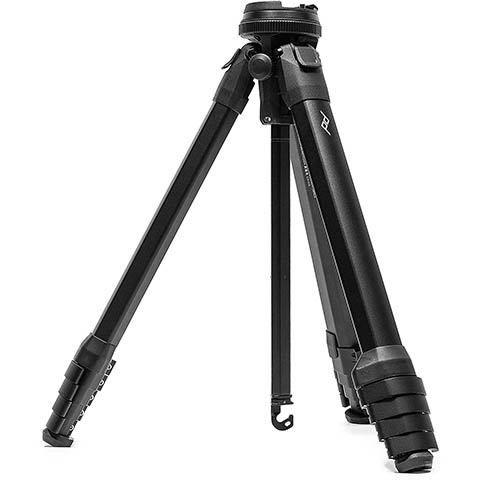
| Build: | Aluminum |
| Weight: | 3.44 pounds |
| Minimum height: | 5.5 inches |
| Maximum height: | 60 inches |
| Capacity: | 20 pounds |
Our best overall choice is the aluminum Peak Design Travel Tripod. This tripod is a marvel of engineering, with a unique build that packs away better than any other competitor in its category. It has a weight capacity of 20 pounds, so you can throw on a heavy rig and be confident that it will stay put.
The ball head has a twistable joint to fluidly move the centerpiece 270 degrees and can be orientated for portrait-style shots. Also, the top portion utilizes a twist mechanism to lock and unlock an Arca-Swiss compatible plate. The company does sell a universal head adapter if you prefer that.
In between the legs, there’s a bonus phone mount integrated into the hook, which can hold your backpack for additional sturdiness. Plus, you can invert the middle ball-head area and flip it upside down to get to ground level. It isn’t the most stable on our list but does struggle with heavy winds. However, it still is a great option for the majority of people.
- Compact
- Easy to use
- Replaceable parts
- Clamping legs
- 260-degree tilt
- Expensive
- Low wind resistance
2. AOKA 15.7” Carbon Fiber Tripod – Best Value
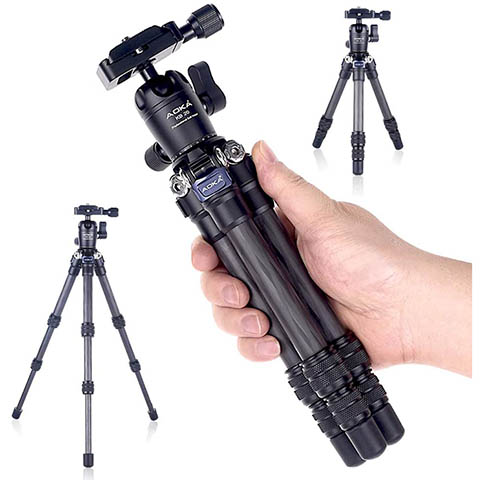
| Build: | Carbon fiber |
| Weight: | 0.97 pounds |
| Minimum height: | N/A |
| Maximum height: | 25.2 inches |
| Capacity: | 6.6 pounds |
For little money, this tripod is unbelievably compact and lightweight. The ball head is movable and can smoothly turn to a vertical position. It comes with a useful level tool for balancing the camera and features a quick-release plate for ease of use.
This is definitely the best backpacking tripod for the money if you need to cut down on pack weight and your budget. With that in mind, you should still know that the maximum height is not the greatest and is suited for compositions that don’t have tall objects in the way. The weight capacity of just 6.6 pounds compromises your ability to put heavy gear on it as well. Luckily, most setups won’t be over this weight if you’ve got just a small mirrorless body and nothing more than a telephoto lens.
- Lightweight and compact
- Affordable
- Storage bag included
- Replaceable parts
- Level included
- Twisting leg closure
- Low Maximum height
- Weight capacity
3. Peak Design Carbon Travel Tripod – Premium Choice
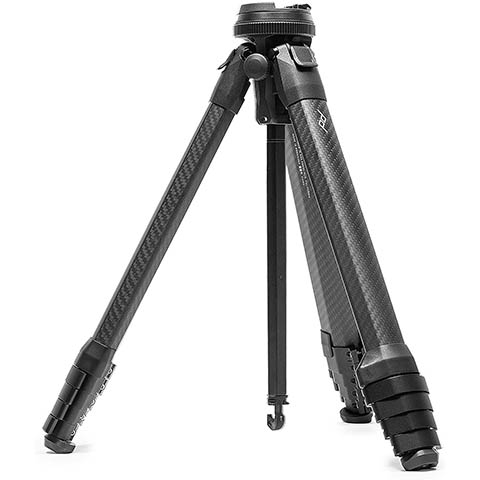
| Build: | Carbon fiber |
| Weight: | 2.81 pounds |
| Minimum height: | 5.5 inches |
| Maximum height: | 60 inches |
| Capacity: | 20 pounds |
The best premium pick we have is the Peak Design Travel Tripod made of carbon fiber. You get all the bells and whistles in the aluminum versions, but with better performance. Although it’s not budget-friendly, the feature set is plentiful, and the package is worth the money.
By the way, both versions do come with a high-quality neoprene storage bag that gives you a bushing-removal tool for maintenance. There are more stable carbon-fiber tripods out there, but none truly match the design of this one.
- Lightweight
- Replaceable parts
- Stable
- Clamping legs
- Expensive
- Ball head isn’t 360 degrees
4. LEOFOTO LS-223C Carbon Fiber Tripod
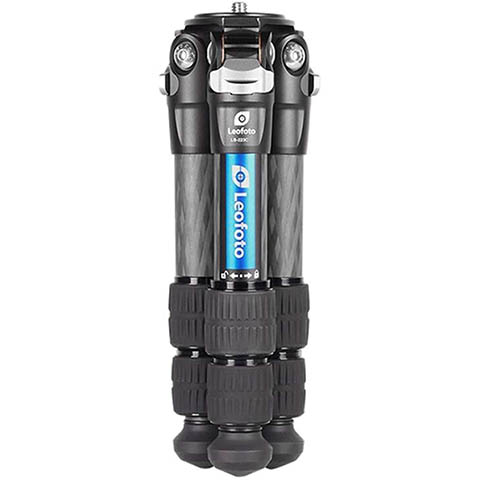
| Build: | Carbon fiber and steel alloy |
| Weight: | 1.17 pounds |
| Minimum height: | 1.6 inches |
| Maximum height: | 12.4 inches |
| Capacity: | 22 pounds |
With a weight capacity of 22 pounds, the LEOFOTO LS223C seriously competes with other tripods on this list at a fraction of the cost. It even comes with a bag for storage, and its parts can be removed, cleaned, or replaced. What’s the catch? Well, it seriously compromises the maximum height limit because it’s considered a table tripod. This means you won’t be able to get the reach to get over an obstacle if it’s in the way. Fortunately, you can still put it pretty much anywhere, and it stows away like it isn’t even there.
- Compact
- Affordable
- Storage bag included
- Replaceable parts
- Low maximum height
- Fixed orientation/head
- Center column sold separately
5. Manfrotto Compact Action Aluminum 5-Section Tripod
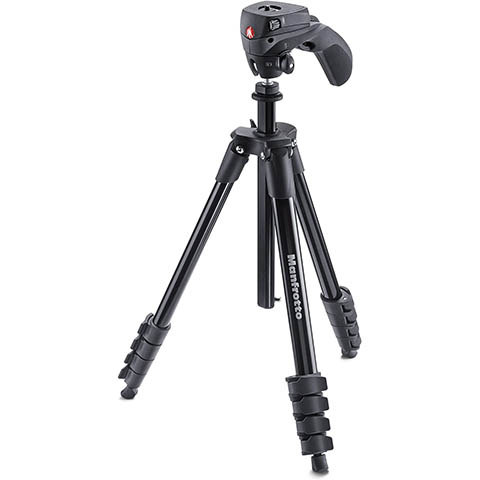
| Build: | Aluminum |
| Weight: | 2.65 pounds |
| Minimum height: | 17.3” |
| Maximum height: | 61” |
| Capacity: | 4.4 pounds |
Manfrotto is a well-known brand in the photo and video world, so you can trust that they will deliver quality results. With their popular Compact Action Aluminum 5-Section Tripod, they incorporate a functional ball head that maneuvers freely and offer mounting options, such as their proprietary quick-release system, in addition to a few other phone, action, and advanced mounts.
Its design is simple yet practical, and the clasping legs make the setup so much faster. On the other hand, the aluminum build kills how strong it could be, as it can only carry up to 4.4 pounds. That isn’t great, considering that some hikers may want to use a larger lens for their landscape imagery. We do think that it’s the best alternative to Peak Design’s aluminum travel tripod.
- Variety of mounting choices
- Tall maximum height
- Clasping legs
- Lightweight
- Storage bag included
- Aluminum build isn’t sturdy
- The ball-head option is bulky
- Only supports 4.4 pounds
6. SIRUI AM-1204K Carbon Fiber Tripod

| Build: | Carbon fiber |
| Weight: | 3.66 pounds |
| Minimum height: | 18.3 inches |
| Maximum height: | 63.8 inches |
| Capacity: | 30.9 pounds |
One of the best choices you can make for hiking or backcountry trekking is the SIRUI AM-1204K. This carbon fiber model has a whopping 63.8 inches of vertical headroom, so you can reach over pretty much anything. On the other hand, it might be too tall for some to use, so we recommend it for those who take photos cameras that have swiveling screens to make it more convenient.
For its size and stability, the weight of this is admirable. Although it isn’t under 3 pounds, it still is one of the most stable tripods out there. The ball head that’s included is easy to use and comes with a quick-release plate and parameters that can be adjusted with screw locks. They gift us a handy storage bag, too.
- Sturdy
- Lightweight
- Storage bag included
- Ball head mount
- Bulky
- Expensive
- Twisting legs
7. Pedco Ultrapod 3 Lightweight Camera Tripod

| Build: | Plastic |
| Weight: | 4 ounces |
| Minimum height: | 5 inches |
| Maximum height: | 5 inches |
| Capacity: | N/A |
For those of you who plan on exclusively using your phone, action camera, or small rig, this is an excellent choice. The design is minimal, sturdy, and it’s simple to deploy. Its legs are designed in a way so that they can be staked into the ground, which keeps things stable and is great for different environments.
There are a few issues with this tripod, which are mostly to do with its extremely limited maximum height and plastic build. When setting up a small DSLR or mirrorless camera, you’ll have to use a lighter, more compact lens to ensure that the center of gravity is balanced. Otherwise, you should have no problems. You can even use this thing as a selfie stick or monopod too.
- Lightweight
- Affordable
- Can be staked into the ground
- Low maximum height
- Plastic materials aren’t durable
8. Amazon Basics 60” Lightweight Tripod
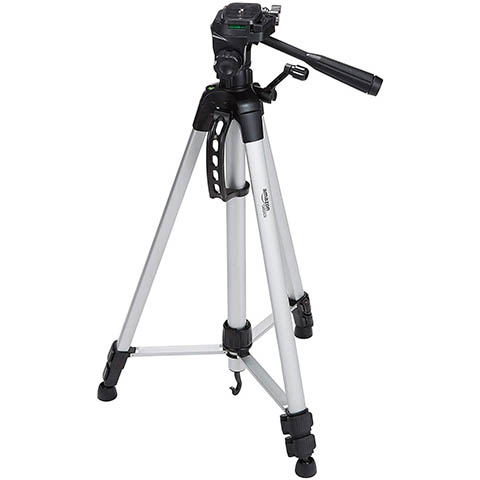
| Build: | Aluminum |
| Weight: | 3 pounds |
| Minimum height: | 23.8 inches |
| Maximum height: | 60 inches |
| Capacity: | 6.6 pounds |
We couldn’t complete this list without one of Amazon’s own lines of products. Amazon Basics provides a lot of value for their prices, and this tripod has all the essential features you need to get things done at a cost that can’t get much lower.
However, it obviously can’t go up against the higher-quality tripods made with carbon fiber, and it won’t be nearly as durable or compact. Still, there is a lot involved in this choice, though, as you’ll be getting a fully panning head with nice add-ons, like an integrated level and a center column hook to use your back as ballast for more stable performance. This product, in many ways, is similar to our Manfrotto review but for less money. It just doesn’t have the same quality.
- Affordable
- Panning head
- Integrated level
- Poor construction
- Heavy
- Bulky
- Poor wind resistance
9. Ubeesize Tripod S
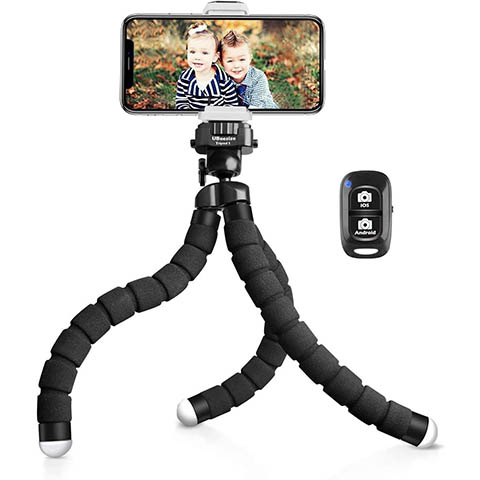
| Build: | Metal, rubber |
| Weight: | 0.4 pounds |
| Minimum height: | Fixed |
| Maximum height: | Fixed |
| Capacity: | 1.1 pounds |
Flexible tripods have become a common piece of a kit for many outdoor enthusiasts because of their bendable legs and comfortable grip. Ubeesize sells their tripod for a low price and can be maneuvered however you need. Backpackers, hikers, and the like will benefit from this style for its ability to not only be used as a tripod but also as a compact monopod or as its own mount.
You can bend the legs in a way so that they can be attached to tree branches, rocks, or just on the ground. Ubeesize throws in a bonus self-timer remote with wireless capabilities. You’ll need to recharge it every so often, though. Unfortunately, the compromise is its weight limit. Only phones, action cameras, or compact camera bodies will be able to keep it from falling over, and strong winds can be brutal against it.
- Affordable
- Bendable
- Easy to travel with
- Poor construction
- Fixed height
- Low weight capacity
- Poor wind resistance
10. SelfieShow Selfie Stick Tripod Stand
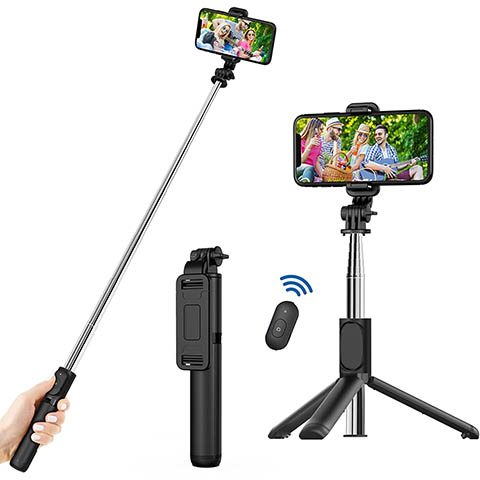
| Build: | Plastic, stainless steel |
| Weight: | 0.33 pounds |
| Minimum height: | N/A |
| Maximum height: | 39.7 inches |
| Capacity: | N/A |
The last choice we’ve got on this list is the cheapest, but it’s also the one with the lowest quality. The feature set is actually quite good, as it packs both a selfie stick, tripod stand, and remote shutter all in one tiny package. It has a telescoping center portion that extends to approximately 39.7 inches which is great for its size.
However, you will be limited to mounting a small phone or action camera. This is the best option for people who aren’t looking for the best tripod for hiking but instead need something that will perform basic needs at the lowest possible cost. Any sort of wind will most likely knock it over, so you might want to stand in the direction that the gusts are coming from.
- Remote shutter included
- Easy to travel with
- Poor
- wind resistance
- Low weight capacity
- Easy to break

Buyer’s Guide: How to Select the Best Lightweight Tripods for Backpacking
The main factors that you want to look out for when buying the best tripod for hiking are things like stability, compactness, weight, ease of use, replaceability, and materials. Below, we’ll go into detail about some of these factors and more of what you should look out for.
Compactness and Weight
It’s easy to leave behind a big tripod if it takes up too much space on your pack, which is why smaller versions can be beneficial. Most of the time, tripods are attached externally with straps or get shoved into a side pocket because they take up so much space inside your bag. It’s a good idea to see the dimensions of the tripod to properly estimate if it will fit in those places.
Lightweight gear is always a must when walking long distances, especially at an incline. For this, you may want to stay under 3 pounds because you already could be carrying other heavy camera gear. However, if you prioritize price or the highest amount of stability possible over this, then it might not be feasible.
Practicality
Photography and video equipment can be time-consuming to set up and put away. Some tripods have features and designs that ultimately make the process much more convenient. For example, a tripod with legs that requires you to twist each part by itself can be a tedious task. We don’t want this to be a problem when we’re on the move and switching locations often. Instead, the better way to go is the clamping legs, which can be deployed together in one movement.
The minimum and maximum height are also important to know because you may be doing some ground-level landscape compositions or need to reach over an obstacle. Additionally, you’ll want to know the weight of your rig and see if it is within the limit of the model you’re looking at.
If you are just using a phone, tripod designs that cater to these will be easier to deal with because they likely won’t require mounts or plates. Plus, a few manufacturers will integrate phone mounts into their design, which adds some resourcefulness.
Materials
When buying a tripod for outdoor use, durability should be a huge priority. On the trails, you’ll likely encounter water, sand, snow, dirt, salt, rocks, and other elements that can only be defended against with the right construction. In this case, you’ll want carbon fiber or aluminum, as they are the best defense against these factors. Carbon fiber is more expensive, but it has better wind resistance, is lighter, and provides greater stability.

Replaceability
Although quality materials will be long-lasting, they won’t stave off the wear from constant use forever. That’s why it’s a good idea to see if the model you’re after has parts that can be swapped out in case something breaks.
Usually, reputable brands will offer ball head, individual legs, and case replacements for a modest price in addition to maintenance and care instructions. Some companies will also offer extra items to enhance or simplify their functionality.

Conclusion
To sum it all up, Peak Design has both the best overall and best premium options. They are simple, compact, and easy to use, and almost anybody with a camera can benefit from them. Our best budget choice was the AOKA carbon fiber tripod, which is perfectly fine for hiking as long as you don’t need a ton of height.
So, there you have it—a list of the best hiking tripods that we recommend for anyone who needs to create content on the trails. We hope this guided you to the right purchasing decision so you can get out there and take in nature without feeling weighed down.
Featured Image Credit: artsysolomon, Pixabay
Table of Contents
- A Quick Comparison of Our Winners (2024)
- The 10 Best Lightweight Tripods for Backpacking
- 1. Peak Design Aluminum Travel Tripod – Best Overall
- 2. AOKA 15.7” Carbon Fiber Tripod – Best Value
- 3. Peak Design Carbon Travel Tripod – Premium Choice
- 4. LEOFOTO LS-223C Carbon Fiber Tripod
- 5. Manfrotto Compact Action Aluminum 5-Section Tripod
- 6. SIRUI AM-1204K Carbon Fiber Tripod
- 7. Pedco Ultrapod 3 Lightweight Camera Tripod
- 8. Amazon Basics 60” Lightweight Tripod
- 9. Ubeesize Tripod S
- 10. SelfieShow Selfie Stick Tripod Stand
- Buyer’s Guide: How to Select the Best Lightweight Tripods for Backpacking
- Conclusion
About the Author Robert Sparks
Robert’s obsession with all things optical started early in life, when his optician father would bring home prototypes for Robert to play with. Nowadays, Robert is dedicated to helping others find the right optics for their needs. His hobbies include astronomy, astrophysics, and model building. Originally from Newark, NJ, he resides in Santa Fe, New Mexico, where the nighttime skies are filled with glittering stars.
Related Articles:
Holy Stone Drone Review of 2024 – Pros, Cons, and Verdict
Ultraviolet Light vs Black Light: What’s the Difference?
Light Waves vs. Sound Waves: How Are They Different?
Infrared vs. Thermal Cameras: How Are They Different?
Far Infrared vs Near Infrared: What’s The Difference?
Mottled Duck vs. Mallard vs. Black Duck: What’s the Difference?
Shutter Speed vs Frame Rate: Pros, Cons, & Difference
Oriole vs Goldfinch: How to Tell the Difference



